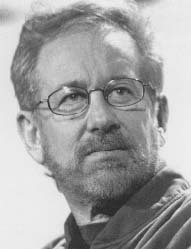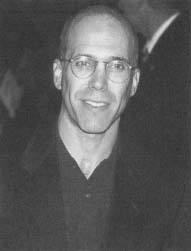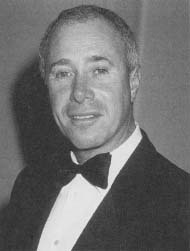Steven Spielberg
Born: December 18, 1946
Cincinnati, Ohio
Filmmaker and cofounder, DreamWorks SKG

Some filmmakers want to make audiences laugh or cry or jump out of their seats with fright. Others want to make people think about important historical events and the values people need to live a good life. In his career, Steven Spielberg has done both: entertain and educate, produce basic emotions and stir deep thoughts. Along the way, he has become the most successful filmmaker of all time.
Young Man with a Camera
Steven Allan Spielberg was born on December 18, 1946, in Cincinnati, Ohio. His parents, Arnold and Leah, also had three younger daughters. Arnold Spielberg, an electrical engineer, moved often because of his career. As a result, young Steven had a hard time making friends. He also felt like an outsider because of his Jewish faith, and loneliness and isolation became common themes in his adult work.
"People like Steven don't come along every day, and when they do, it's an amazing thing. It's like talking about Einstein or Babe Ruth or Tiger Woods. He's not in a group of filmmakers his age; he's far, far away."
— George Lucas, creator of Star Wars, in Time, 1997
By the time his family settled in Phoenix, Arizona, Spielberg had developed an interest in filmmaking. Making movies, he later told an interviewer, gave him control. In 1958, Spielberg's father encouraged him to make a movie for his Boy Scout troop. By the time he was a junior in high school, he had won an award for his short film Escape to Nowhere, and written and directed a full-length science-fiction film, Firelight. After high school, Spielberg enrolled at California State College at Long Beach, mostly to avoid becoming eligible for the military draft during the Vietnam War (1959-75). Spielberg did not care about classes; he planned to make films on his own and pursue a career in Hollywood.
In 1968, Spielberg completed his first project shot on 35 mm film, the standard used in professional productions. That short, Amblin', earned him a job at Universal Studios. He had hung out at the studio in the past, starting in high school. Sid Sheinberg, a vice president at the studio, saw the film and offered Spielberg a job directing TV shows and movies. He was just twenty-two when he directed his first television episode. Two years later, Spielberg made the TV movie Duel, a thriller shot in less than three weeks. The film won rave reviews and led to Spielberg's first chance to direct a feature film.
Sharks, Aliens, and Raiders
That picture, Sugarland Express, earned good reviews but did not make much money. Spielberg's first huge success was Jaws in 1975. At the time, it was the biggest moneymaker ever, selling more than $130 million in tickets. Two years later, Jaws was followed by another hit, Close Encounters of the Third Kind. Not everything Spielberg made was popular: the 1979 comedy 1941 was a colossal flop, and the director told the New York Times, "I'll spend the rest of my life disowning this movie." Throughout his career, several of Spielberg's films were disappointments, to critics or fans, or both. But his successes were so huge, no one paid attention to the misses for long.
Steven Spielberg's mother, Leah, studied classical piano and encouraged her son's artistic efforts. She appeared in some of his early homemade films. In one, she played a soldier driving a jeep, with a helmet covering her short blond hair.
Working with his friend George Lucas (1944-), Spielberg directed the adventure comedy Raiders of the Lost Ark in 1981. The success of that film led to two equally popular sequels. As usual, Spielberg showed a flair for special effects and leaving audiences emotionally drained after a thrilling, hair-raising ride. His next film, E.T: The Extra-Terrestrial, showed Spielberg's more emotional side, and a connection to the dreams and pains of childhood. This theme appeared in other Spielberg films, and he admitted that he was like the fictional character Peter Pan—a boy at heart who didn't want to grow up. (In 1991, Spielberg released his own version of the Peter Pan story, Hook.)
Jeffrey Katzenberg: The
"Golden Retriever"
Working for Michael Eisner at both Paramount Pictures and the Walt Disney Company, Jeffrey Katzenberg was sometimes called "the Golden Retriever." He tracked down and brought back the creative talent Eisner wanted for Disney films. After years of loyal service, Katzenberg was stunned when he did not get the president's job at Disney in 1994. His bitterness helped fuel the start of DreamWorks SKG, and motivated many of his efforts with his new company.

Born in 1950, Katzenberg grew up in New York and had an early interest in politics. He worked for New York Mayor John Lindsay (1921-2000) during and after high school, then decided to enter the entertainment industry. In the early 1970s, he began working at Paramount Pictures, taking several positions before teaming up with Eisner, who named him production chief at the studio in 1982. Although just thirty-one at the time, Katzenberg was known for his discipline and determination, working long hours and expecting employees under him to do the same.
In 1984, Katzenberg followed Eisner to Disney to run that company's film operations. Under Katzenberg, the studio was known for cutting costs, often hiring actors who were considered out of favor with the public. Katzenberg also turned around the animation division, which had not produced a major film in years. At first, he had no strong love for animation. But by the time Katzenberg finished with the production of Who Framed Roger Rabbit? in 1988, which combined animation and live-action, he was dedicated to animated films.
When he, Steven Spielberg, and David Geffen started DreamWorks, Katzenberg wanted to challenge Disney as the top studio for animation. He was actively involved in the company's first major animation project, The Prince of Egypt (1998). He also denied that he stole the idea for the film Antz from a similar film released by Disney, A Bug's Life. Both films featured big stars providing voices for insects created on computers. DreamWorks released Antz earlier than it originally planned so it could reach theaters before the Disney film did. Katzenberg also convinced some Disney animators to join his new company, and the DreamWorks animation studio was built near Disney's.
Katzenberg's rivalry with Eisner and Disney had a legal component as well. Kaztenberg sued Disney, saying the company owed him money for the films he had made for them. The lawsuit dragged on for three years, but Katzenberg eventually won a settlement worth about $250 million. He admitted the long lawsuit had not been good for DreamWorks. He told the Los Angeles Times in July 1999, "Was my attention distracted by this?… Did the company suffer? Yes, but it's hard to quantify how it did."
Katzenberg, famous for his energy, ran most daily operations at DreamWorks. Still, despite his responsibilities and his past successes, he was quick to praise his partners. "I feel like I work for Steven and David," he told the Los Angeles Times in 1998. "They're smarter; they're more successful.… I have a lot more to prove. That's why I have to work harder."
Although making movies was his first love, Spielberg also took an interest in the business side of Hollywood. After the success of Jaws he set up his own production company called Amblin'. (The company name was later changed to Amblin Entertainment.) The first film he produced, but did not direct, was I Wanna Hold Your Hand (1978). During the 1980s, his successful productions included Gremlins (1984), the three Back to the Future movies (1985, 1989, 1990), and Who Framed Roger Rabbit? (1988). As a producer, Spielberg shaped the careers of several other popular directors, including Robert Zemeckis (1952-), who continued to work with him at DreamWorks SKG.
David Geffen: From Music
to Movies and More
When a Japanese electronics firm bought entertainment company MCA in 1990, David Geffen became the richest person in Hollywood. Earlier in the year, Geffen had sold his record company for ten million shares of MCA stock. The MCA sale gave Geffen $660 million, plus a share of a TV station. Added to his existing wealth, Geffen was just shy of becoming a billionaire—a milestone he soon reached.

Born in 1943 in Brooklyn, New York, Geffen credits his mother Batya with sharpening his business skills. His mother ran a corset shop, and she taught him, as he told Forbes in 1990, "how not to get hustled." Not a good student, Geffen gave up on college to enter the entertainment world. He worked as an usher at the CBS television studios in California, then as a receptionist for a TV production company. His big break came in 1964, when he landed a job in the mailroom at the William Morris talent agency in New York City. Geffen soon became an agent, and his first big client was singer/songwriter Laura Nyro. When Nyro formed a song publishing company, Geffen owned half. The partners sold the company in 1969, and Geffen made his first million.
Soon after, with financial backing from Atlantic Records, Geffen founded his own record company, Asylum. His acts included Jackson Browne (c. 1948-), Linda Ronstadt (1946-), and the Eagles. Through its connection with Atlantic, Asylum was part of Warner Communications, a huge company that also produced films. Warner eventually bought out Geffen's share of Asylum and named him president of Elektra/Asylum records. In 1975, Ceffen entered a new arena, becoming vice chairman of Warner's film division. That job ended the next year, when Ceffen was mistakenly diagnosed with cancer. During the next several years, he focused on medical treatments for a disease that was not as dangerous his doctors thought.
During the 1980s, Geffen returned to the music business full-time, founding Geffen Records and DGC (for David Geffen Company). One of its star acts was Nirvana. In film, Warner Brothers helped him start his own production company. His other interests included collecting art and producing Broadway plays. Geffen sold his company in 1990 and had less direct involvement in the daily operations of his other business interests. He also contributed to organizations related to AIDS. The disease was particularly deadly among homosexuals, and after years of secrecy, Geffen publicly announced his homosexuality in 1992.
When Jeffrey Katzenberg asked Geffen to join him and Steven Spielberg in a new entertainment company, Geffen hesitated. He did not always share power well. But Katzenberg convinced him that starting what became DreamWorks would be a rewarding challenge.
Known for his strong business sense—and getting his own way—Geffen shaped the proposal that brought DreamWorks its initial investments. He, Katzenberg, and Spielberg received a two-thirds share of the company and total control over the operations for a combined $100 million while outside investors put in $900 million for the remaining one-third of the company. Although some business analysts questioned the arrangement, Geffen told Fortune in 1995 that "the names of those who've invested with us speak for themselves. No one has walked away because of the terms." Geffen's track record in the entertainment industry played a part in reassuring investors that DreamWorks was a good investment.
The Serious Side of Spielberg
In 1986, Spielberg surprised many people when he released The Color Purple. Based on the book by African American author Alice Walker (1944-), the movie addressed sexual abuse in the Deep South. The film won several Academy Award nominations, including one for Best Film, although Spielberg was not nominated for Best Director. Some critics thought Spielberg had toned down the emotional core of the book, making it more sentimental—a trait of many of his films. Still, The Color Purple showed that Spielberg could make films for adults that did not rely on expensive special effects.
Spielberg reached deep into his roots in 1993 when he directed Schindler's List. Based on a true story, the film depicts how a German businessman helped Jews escape certain death at concentration camps where Nazi Germans killed millions of Jews and other so-called "undesirable" people during World War II (1939-45). Shot in black-and-white, the film was more than three hours long, and no one expected it to become the blockbuster that it did. Schindler's List let Spielberg explore his Jewish heritage while showing people the horrors of what is known as the Holocaust. Steven Spielberg donated all the profits he made from Schindler's List to various Jewish organizations, including the U.S. Holocaust Memorial Museum in Washington, D.C. The film earned Spielberg his first Academy Award for Best Director.
The same year, Spielberg showed his other side, the one fascinated with science fiction and high-tech filmmaking. Jurassic Park used digital technology to bring dinosaurs to life, and the film set box-office records, eventually earning almost $1 billion worldwide. It also led to two sequels, although neither was as popular as the original. Spielberg returned to more serious filmmaking in 1998 with Saving Private Ryan, which earned him his second Academy Award for Best Director.
Life at DreamWorks
By 1994, Spielberg was worth an estimated $600 million. He had a family with his second wife, Kate Capshaw (1953-), that included her daughter from a first marriage, Spielberg's son from his first marriage (to actress Amy Irving), and three children of their own, two of whom were adopted. The rigors of joining Jeffrey Katzenberg and David Geffen in a new company were not appealing, especially to his wife. But according to Kim Masters in The Keys to the Kingdom, Spielberg was once again attracted to the idea of control.
Spielberg was certainly the "star" of the three owners, considered the greatest filmmaker of his generation. He asked for and received the freedom to make movies for other studios, which would also give him an outside paycheck if DreamWorks stumbled. The sequels to Jurassic Park were not DreamWorks productions. Most of his films for the new company were co-productions, as was his ten-part series for television, Taken. Released in December 2002, the series brought Spielberg back to his television roots and continued his interest in science fiction, where a creative person has unlimited freedom. "It doesn't have boundaries," he told the SciFi Channel. "It doesn't fence you in … it frees the imagination to journey anywhere it can imagine itself."
For More Information
Books
King, Tom. The Operator: David Geffen Builds, Buys, and Sells the New Hollywood. New York: Random House, 2000.
Masters, Kim. The Keys to the Kingdom: How Michael Eisner Lost His Grip. New York: William Morrow, 2000.
McBride, Joseph. Steven Spielberg. New York: Simon & Schuster, 1997.
Periodicals
Bates, James. "Reality is, DreamWorks Never Needed a Studio." Los Angeles Times (July 30, 1999): p. 6.
Brown, Corie. "Making the Dream Work." Newsweek July 19,1999): p. 42.
Corliss, Richard, and Jeffrey Ressner. "Peter Pan Grows Up." Time (May 19, 1997): p. 74.
Eller, Claudia. "DreamWorks Wakes Up to Reality." Los Angeles Times (July 13, 1999): p. 2.
Eller, Claudia, and James Bates. "Animated Features Aren't Studio's Dream Come True." Los Angeles Times (April 28, 2000): p. A-1.
Gubernick, Lisa. "California Dreamin'." Forbes (July 29, 1996): p. 42.
Gubernick, Lisa, and Peter Newcomb. "The Richest Man in Hollywood." Forbes (December 24, 1990): p. 94.
Kilday, Gregg. "In the Works." Entertainment Weekly (October 20, 1995): p. 38.
Miller, Greg. "DreamWorks, Imagine in Venture to Showcase Online Programming." Los Angeles Times (October 26, 1999): p. 1.
Munoz, Lorenza. "The Mudslinging in the Wetlands." Los Angeles Times (April 24, 1999): p. 6.
Nelson, Scott. "At DreamWorks, Katzenberg Holds the Reins." Boston Globe (May 19, 2002): p. L14.
"Savoring Private Ryan." U.S. News & World Report (February 22, 1999): p. 49.
"Steven Spielberg Presents Taken." The Sci Fi Channel. [On-line] http://www.scifi.com./taken/press/productionannouncement.html (accessed on August 15, 2002).
Serwer, Andrew. "Analyzing the Dream." Fortune (April 17, 1995): p. 71.
Spring, Greg. "DreamWorks Attracts Two Big Names." Los Angeles Business Journal (March 27, 1995): p. 5.
Turner, Richard, and Corie Brown. "Fishing Buddies." Newsweek (September 29, 1997): p. 68.
Wallace, Amy. "Creating 'The Prince of Egypt' Led Jeffrey Katzenberg and His DreamWorks Associates to Throw Out Most of Animated Film's Rules." Los Angeles Times (November 22, 1998): p. 2.
. "Ouch! That Stings!" Los Angeles Times (September 21, 1998): p. 6.
Young, Josh. "Needs Improvement." Entertainment Weekly (October 17, 1997): p. 27.
Web Sites
DreamWorks SKG. [On-line] http://www.dreamworks.com (accessed on August 15, 2002).
DreamWorks SKG Fansite. [On-line] http://www.dreamworksfansite.com (accessed on August 15, 2002).
Comment about this article, ask questions, or add new information about this topic: